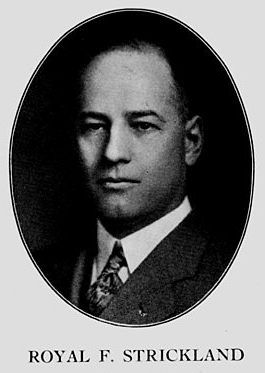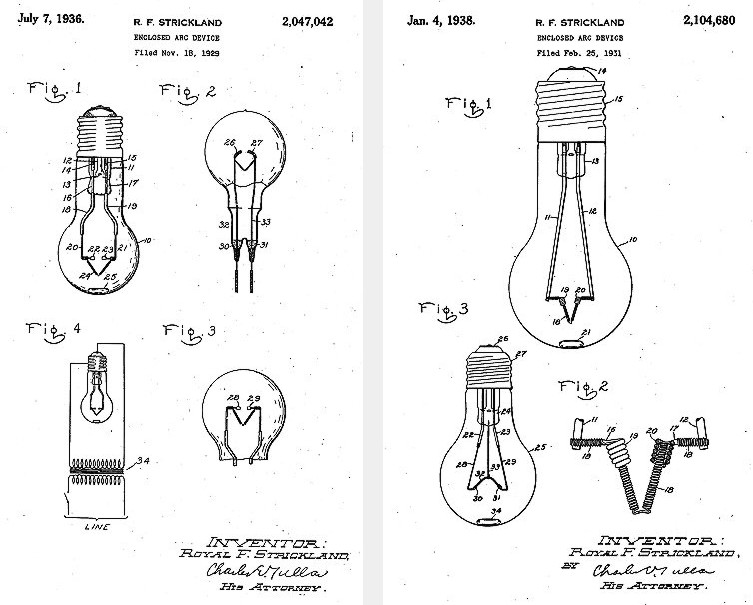|
|
|
This article is based on a document of fellow lamp engineer and collector Edward J. Covington, which appeared on his website of biographical sketches of persons involved in the lamp industry. Following his passing in February 2017 and with kind permission of his family, Ed's words have been preserved and subsequently expanded with new material by this author, to maintain continued access to the research he initiated.
|

Royal F. Strickland |
Biography
Royal F. Strickland (Aug 17 1883 - Sep 13 1947) was an inventor who spent his entire working career with the National Electric Lamp Association and General Electric. He worked primarily in lamp development and at least ten patents were granted to him. He is most well known as the inventor of the modern vacuum-metallized blown-reflector lamp, and the type S-1 and S-2 mercury discharge suntanning lamps - each of which will be described in the sections below.
Royal Strickland was a native of North Eaton, Ohio and graduated in 1908 from Case School of Applied Science in Cleveland. He was the son of George F. and Rilla (Marcy) Strickland. On Oct 1 1908 he entered the Engineering Department of National. In 1909 he transferred to the Lamp Testing Department of the Lamp Development Laboratory, and in 1910 became an engineer in the Wire Laboratory. In 1913 he returned to the Lamp Development Laboratory at Nela Park.
Royal Strickland married Frances M. Thomson, a native of England, on Sep 22, 1909; they had three children: Dean, Robert and Gertrude. Strickland passed away in 1947 and was laid to rest in Knollwood Cemetery, Mayfield Heights, Ohio.
Development of the Sunlight Mercury Lamp
Two of Strickland's patents were for an enclosed arc device, the S-1 and later also the S-2 Sunlamps. It was a new lamp type that proved to be quite popular, being a combination of tungsten filament and mercury arc. The radiation from the lamp was rich in actinic and ultra-violet rays. Strickland had thought it possible as early as 1925 to develop an "instantly" starting lamp. However, at that time there was no glass available that would allow ultraviolet rays to be transmitted. By 1929 a glass was developed and patents for the lamp were applied for. These were: No. 2,047,042, issued Jul 7 1936, and No. 2,104,680, issued Jan 4 1938. The first pages of these two patents are shown below.
|

Patent Drawings of the Mercury-Tungsten Sunlamps
|
Development of the Reflector Lamp
Strickland is credited as being the father of the first practical reflector lamps, following his 1936 development of vacuum metallizing part of the inside surface of specially shaped glass bulbs with an internal aluminium mirror coating.
Of course reflector lamps had existed prior to this date, but they were quite inferior. At first it was standard practice to partially enclose a conical-shaped lamp within a matching cup of white opal glass - this being a relatively good reflector of diffuse light. The diffusing nature of the white reflector lamps, however, could not project a beam of any significant luminous intensity or with beam angles much less than a lambertian distribution.
Later developments saw the application of silver mirrors to the external surface of the bulb. At first these were notoriously unreliable - the silver being attacked by the air and tarnishing rapidly, as well as being vulnerable to removal by scratching with even the most careful handling. A 1935 development by the Silvray Company of New York1 introduced an improved process in which the silver mirror was sealed under an electroplated layer of copper to prevent tarnishing, and then painted with a thick layer of aluminium flakes to achieve the necessary scratch-resistance. The Silvray company did not licence its patents and for a number of years achieved tremendous success by coating the reflector lamps of all of the principal American lamp manufacturers.
Strickland's concept was based on vacuum metallizing. A small piece of aluminium wire was placed within a heavy-duty tungsten filament, temporarily mounted inside the glass bulb to be coated, and the bulb then evacuated. By heating the filament the aluminium is melted and promptly vaporised, coating all exposed parts of the inner surface of the bulb in which there is a line-of-sight to the filament. Partial coating, for instance in the case of reflector lamps, was initially attained by a second process step of dissolving away unwanted aluminium using a solution of warm sodium hydroxide. Later this step was eliminated by placing suitable obstructions within the bulb to create an uncoated 'shadow' in the places where no coating was desired.
The vacuum metallizing process was cheaper, faster, simpler and incontestably superior compared to all previous kinds of reflector lamps. Moreover since the coating is on the internal surface and protected by the inert atmosphere within the lamp, it does not deteriorate during life and cannot be scratched off. Due to GE's licensing agreements with most of the world's principal lamp manufacturers, the technology was swiftly adopted internationally. The first reflector lamps introduced by GE were the 150W and 300W R-40 blown-bulb types, in 19362. The smaller 75W lamp in R-30 bulb followed between 1945 and 19522,
No patent appears to have been granted, despite the great significance of this invention which continues to be applied even today for practically every kind of reflector lamp in current production. The former external silver-coatings were retained only for a few special lamps that would be difficult to coat internally, for instance when the shape of the coated area is too complex to achieve by creating a shadow over the necessary area, and where external masking techniques deliver a more precisely coated region.
|
Patents
- US 1,373,920 - 06.03.1917 - Mounting for incandescent lamps
- US 1,491,436 - 13.05.1919 - Incandescent lamp and similar article
- US 1,722,161 - 04.12.1926 - Method of and apparatus for making incandescent lamps and similar articles
- US 2,032,232 - 13.07.1932 - Incandescent lamp and method of manufacture the same
- US 2,047,042 - 18.11.1929 - Enclosed arc device
- US 2,047,043 - 13.07.1932 - Molding process and article produced thereby
- US 2,081,776 - 19.05.1931 - Enclosed arc device
- US 2,104,680 - 25.02.1931 - Enclosed arc device
- US 2,248,647 - 16.11.1938 - Method and apparatus for sealing envelopes
- US 2,304,859 - 16.11.1938 - Coating apparatusCircuits
- US 2,403,137 - 01.07.1943 - Basing for electric lamps and the like
- US 2,482,442 - 17.09.1945 - Control unit for discharge lamps
References
- "A Century of Light", J.A. Cox, publ. Benjamin Company / Rutledge, 1979, pp.89-90.
- "Lamps for a Brighter America", P.W. Keating, publ. McGraw-Hill, 1954, pp.161,226.
|
|
|
|
|